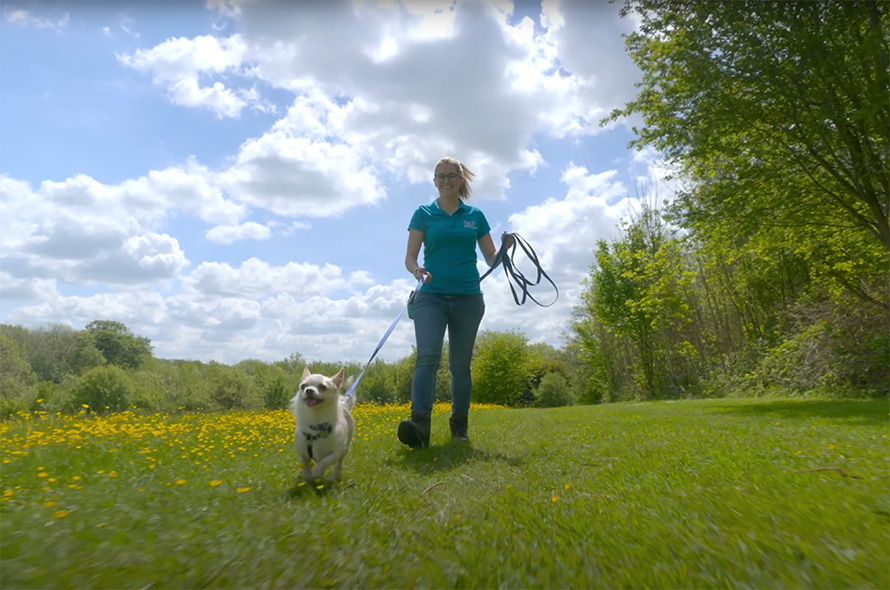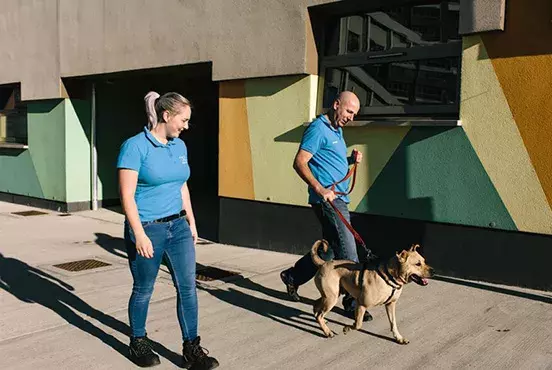A long-line is a long rope with a clip at the end that you can attach to your dog’s harness like you would a normal lead.

Long-lines are great for giving your dog more freedom whilst still having some control of what they are doing. They’re a safe and effective way to practice recall training before letting your dog off lead completely as they give them more freedom and the feeling of being off lead.
As with all things, if your dog’s recall becomes an issue and they don’t seem to be making progress we would recommend contacting a certified dog behaviourist for advice.
Take a look at our advice video on using a long-line lead, or follow along with the steps below:
View the audio transcript for this video
Long-line lead training
Long-lines come in a variety of lengths, from 3 metres all the way up to 30, and it’s important to take the time to get used to holding them properly. They usually have a handle at the end, but you can buy ones without. Long-line leads are a fixed length and are more robust than the retractable long leads you can also buy. They also come in different materials for different sized dogs. For example, a light-weight fabric long-line would be more suitable for a small dog as it won’t weigh them down, but for a larger dog you could look at a biothane, grippy material or a heavy-duty webbing as it’s more robust. Whatever you choose, it’s important to make sure you can hold it comfortably in your hand and that if it pulls through your fingers it’s not going to hurt you.
- First, unravel the line so that there are no kinks or knots.
- Wrap the line up loosely into your hand, creating a hoop to hold.
- We always recommend you attach the long-line to a harness and not a collar so that if your dog runs when they’re at the very end of the line they’re less likely to hurt themselves. If your dog’s harness has fastenings on the front and back we recommend attaching the long-line to the back fastening as this keeps it further from their feet and should help prevent them getting tangled.
- Hold the line with two hands. The hand closest to the dog will manage the slack of the line and can slow them down if needed. Your other hand holds the rest of the line and the handle, if there is one. With your first hand, you can let the line slide through if you are giving your dog more freedom and with your second hand you can pull the line in if you need to shorten the distance or bring your dog towards you. This two-handed method also means you won’t stop your dog too harshly and you have less chance of dropping the line.
- Rather than just pulling the end of the long line when you need to stop your dog you can grip and release the long line using the hand closest to the dog which will slow them down gently to a stop.
- As you build on your dog’s responsiveness you can work up to dropping the long line completely and letting it trail on the ground. This means not holding the lead at all and is the next step, once you’re more confident in their recall, before you work up to letting them off the lead completely. Doing this allows you to keep practicing their recall with the option of having the dog back under control with the lead if needed.
What to look out for
Long-line leads are great in big open spaces, but it’s important to be aware of your surroundings as they can be a trip hazard for others and can get caught up in the environment around you.
- Keep an eye on the length of line your dog has. Even if using a long line that is 5 metres, for example, the dog does not need to have the whole 5 metres reeled out all the time. Too much slack can cause you to get tangled up and even lose control especially if you are in a busy environment.
- Be aware of what’s around you when allowing your dog freedom on the long line. If your dog runs for something and you are caught off guard not holding the line properly it could run through your hands and cause an injury.
- If you or your dog do start to get tangled, try to stop your dog from moving. If they’re food motivated, throw some treats on the floor to divert their attention and keep them still while you untangle.
- If you’ve got to the point where you’re letting the full long-line lead trail on the floor without holding it, you ideally want one that does not have a handle, or if you’re confident in your dog’s progress you could consider cutting the handle off. Without a handle the long-line should move more safely across the ground and should avoid getting caught as easily on things like branches.
- Long-line leads are great for teaching your dog behaviours like a recall in a safe, controlled way. You can find out more about that in our teach your dog a recall video.
Download this guidance as a handy advice sheet and use it to train regularly:

